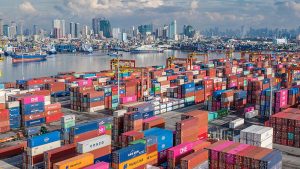Philippines urged to take advantage of opportunities amid US-China trade war
THE PHILIPPINES could be an alternative investment destination for export-oriented firms amid a trade war between the United States and China.

By Justine Irish D. Tabile and Aubrey Rose A. Inosante, Reporters
THE PHILIPPINES could be an alternative investment destination for export-oriented firms amid a trade war between the United States and China.
The US on Tuesday began implementing an additional 10% tariff on goods from China, although US President Donald J. Trump postponed steep tariffs on Mexico and Canada for 30 days.
China quickly retaliated, saying it would impose 15% levies on US coal and liquefied natural gas, and 10% on crude oil, farm equipment and some vehicles, Reuters reported. The new tariffs on US exports will start on Feb. 10, the ministry said. (Read related story: “China hits back with tariffs on US goods as new levies take effect”)
Former Trade Secretary Ramon M. Lopez said the tariff increases on the three countries would make their goods more expensive for US importers, which could present an opportunity for the Philippines.
“The tariff increases on these countries will make their goods more expensive entering the US and may reduce imports from these countries, which means US businesses will seek alternative suppliers,” he said in a Viber message.
“This could present more export opportunities for the Philippines, especially if such products are competitively supplied by the country,” he added.
George N. Manzano, who teaches political economy at the University of Asia and the Pacific, said the Philippines could attract investors that are looking for other countries to use as export platforms “in order to circumvent the tariffs on China.”
“One would expect a lot of investments that are export-oriented originally destined for China looking for alternative locations. The Philippines, with its labor force supply, can tap this opportunity,” he told BusinessWorld on Monday.
However, the aggressive US tariffs could “disrupt the existing supply chains of various goods and destabilize world trade,” Mr. Manzano said.
Meanwhile, GlobalSource Partners Country Analyst Diwa C. Guinigundo said the Philippines could benefit from a possible shift in demand.
“Depending on the similarities of our exports with other affected countries, we could, of course, benefit from a possible shift in demand in favor of Philippine-made products, but this is of course an empirical question,” he told BusinessWorld in a Viber message.
However, Mr. Guinigundo warned that due to interconnected external trade and value chains, higher tariffs could eventually come to the Philippines’ doorstep.
“We could indirectly suffer from shrinking markets should overall exports to these economies are flatly imposed higher tariffs,” he said.
Ateneo School of Government Dean and Economics Professor Philip Arnold P. Tuaño said the US tariffs would be strongly felt in motor vehicle production, motor vehicle parts, oil and petroleum products, computers and mobile phones, which the Philippines could take advantage of.
“We are one of the major exporters of motor vehicle parts, and we can take advantage of suppliers who wish to move from China to take advantage of lower tariffs,” Mr. Tuaño told BusinessWorld in an e-mail.
“With potential tariffs on Chinese computers and phones, US firms may seek alternative suppliers for electronic components, which we are producing in the country,” he added.
Mr. Tuaño also said the Philippines could invite Japanese motor vehicle manufacturers and South Korean suppliers in the country to increase their investments in the Philippines.
Citing data from UN Comtrade, Mr. Tuaño said that cars, crude petroleum, phones, computers, and motor vehicle parts are the top five US import products from Canada, Mexico, and China in 2023.
However, he said the country should improve infrastructure and logistics efficiency to increase its participation in global supply, as well as invest in upskilling to meet the labor demands of emerging industries in the medium term.
Meanwhile, Leonardo A. Lanzona, an economics professor at the Ateneo de Manila University, said the tariffs could present an opportunity to reset the country’s trade policy.
“I suggest that we take this opportunity to reset our trade policy and consider the goods we can truly produce given our comparative advantage, or differentiate to create niches of our own,” he said.
“What is more important is the creation of a comprehensive strategy that focuses on and integrates the opportunities and challenges of digital transformation, climate change and participation in global value chains,” he added.
Mr. Lopez said higher tariffs imposed on goods from Canada, Mexico and China could lead to an inflationary environment, which would indirectly affect the Philippines.
“Higher tariff protection by the US may set a higher bar for domestic prices of affected products and, depending on the magnitude and scale, can be inflationary on the whole,” the former Trade chief said.
“An inflationary environment can increase pressure for higher interest rates in the US and affect the foreign exchange in many countries that can push up interest rates in these countries. All these can lead to greater uncertainties in the global economy,” he added.
The Philippines’ full-year trade balance — the difference between the values of exports and imports — grew by 3.1% year on year to a $54.21-billion deficit in 2024 from the $52.59-billion gap a year earlier, according to preliminary data from the Philippine Statistics Authority.
The United States remained the top destination for Philippine-made goods in 2024, with exports valued at $12.12 billion or 16.6% of the total.
Last month, Trade Undersecretary Ceferino S. Rodolfo said the government would push hard in securing a bilateral free trade agreement (FTA) with the US with the assumption that it would be more possible under the administration of Mr. Trump.
Mr. Trump had welcomed the Philippines’ interest in a bilateral FTA, he said.


















